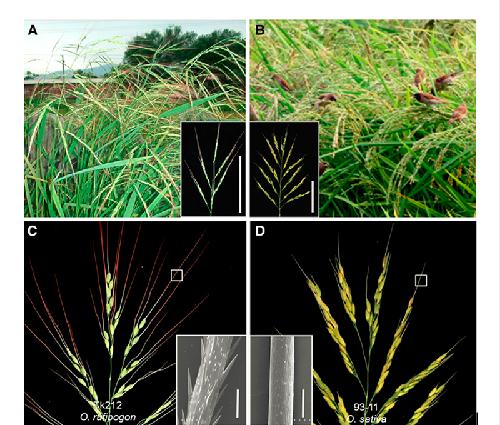The Plant Cell:中国农业大学孙传清教授课题组发表水稻进化最新
中国农业大学农学院教授孙传清领导的课题组,继揭示水稻驯化过程中生长习性、穗型及落粒性改变的遗传机理后,在水稻进化研究上再次取得重要进展——他们发现了水稻驯化过程中引起芒形态改变的遗传变异及其分子演化机制。
该研究结果日前在线发表于The Plant Cell,题目为“LABA1, a Domestication Gene Associated with Long, Barbed Awns in Wild Rice”,并被选为最新一期的研究亮点。
普通野生稻(Oryza rufipogon Griff.)是亚洲栽培稻(O. sativa L.)的野生祖先种,其种子顶端具有长芒,而且芒表面布满芒刺,长、刺芒可以保护种子不被鸟兽掠食因而有利于野生稻的种子传播;而栽培稻一般无芒,或者仅有少量短芒、芒表面光滑,便于稻谷收获、储藏和加工。因此,从长、刺芒到短、光芒,是水稻驯化过程中一个重要转变。

普通野生稻(左)与栽培稻(右)芒性状比较
引起这个关键转变的分子机制是什么?孙传清教授课题组发现:控制野生稻长、刺芒的基因LABA1(LONG AND BARBED AWN 1),位于水稻第4染色体长臂上,编码一个细胞分裂素激活酶。该基因在芒原基的特异表达提高了芒原基活性细胞分裂素含量,增强了芒原基细胞分裂活性,最终引起芒的伸长和芒刺形成。相反,栽培稻中laba1 基因的一个移码突变破坏了该基因功能,阻碍了芒原基的伸长和芒刺的形成,最终导致短、光芒的表型。序列分析表明该功能变异位点在水稻驯化过程中受到了强烈的人工选择,并引起附近~800-kb的基因组区域遗传多样性的剧烈下降。分子演化研究表明,该功能变异起源于粳稻祖先,最终通过杂交渗入到籼稻之中。LABA1的克隆不仅为水稻进化分子机制提供了新线索,也揭示了细胞分裂素在芒发育中的作用。
孙传清教授课题组博士研究生华磊为该论文的第一作者。康奈尔大学Susan McCouch教授课题组和湖南农业大学萧浪涛教授课题组参与了部分工作。
原文链接:
LABA1, a Domestication GENE Associated with Long, Barbed Awns in Wild Rice
原文摘要:
Common wild rice (Oryza rufipogon), the wild relative of Asian cultivated rice (Oryza sativa), flaunts long, barbed awns, which are necessary for efficient propagation and dissemination of seeds. By contrast, O. sativa cultivars have been selected to be awnless or to harbor short, barbless awns, which facilitate seed processing and storage. The transition from long, barbed awns to short, barbless awns was a crucial event in rice domestication. Here, we show that the presence of long, barbed awns in wild rice is controlled by a major gene on chromosome 4, LONG AND BARBED AWN1 (LABA1), which encodes a cytokinin-activating enzyme. A frame-shift deletion in LABA1 of cultivated rice reduces the cytokinin concentration in awn primordia, disrupting barb formation and awn elongation. Sequencing analysis demonstrated low nucleotide diversity and a selective sweep encompassing an ∼800-kb region around the derived laba1 allele in cultivated rice. Haplotype analysis revealed that the laba1 allele originated in the japonica subspecies and moved into the indica gene pool via introgression, suggesting that humans selected for this locus in early rice domestication. Identification of LABA1 provides new insights into rice domestication and also sheds light on the molecular mechanism underlying awn development.
doi:10.1105/tpc.15.00260
作者:孙传清

